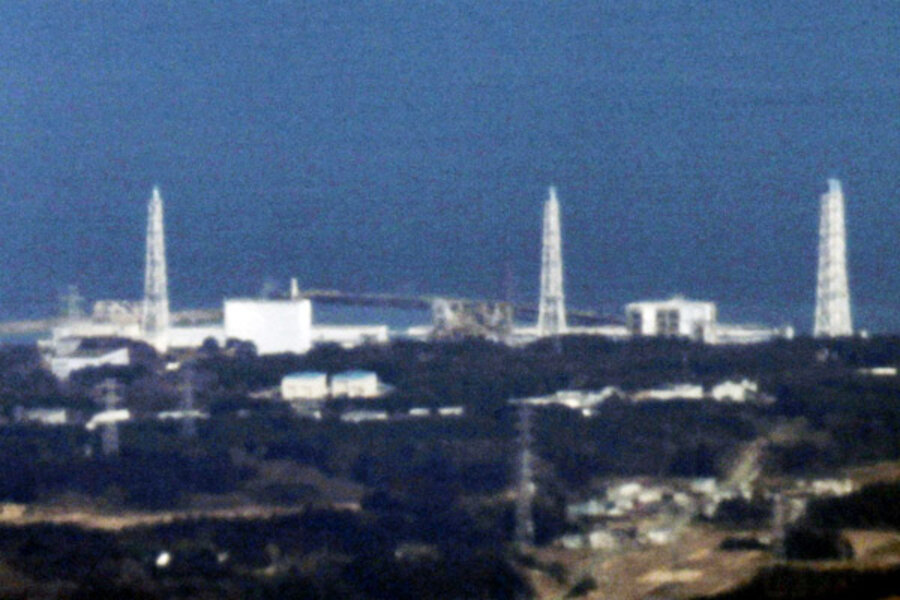Japan crisis: Nuclear agency joins France in raising danger assessment
Loading...
• A daily summary of global reports on security issues.
Japan's nuclear agency raised the danger assessment at Fukushima Daiichi Nuclear Power Station Friday as engineers there continued to spray water on the No. 3 reactor in an attempt to cool spent fuel rods, and as work continued to restore electricity to the plant to bring the electric cooling system back online.
A week after Japan’s largest recorded earthquake sent a tsunami surging over the plant, crippling it, engineers are still struggling to keep the crisis from becoming a full-blown catastrophe. Fuel rods in three of the six reactors are thought to have partially melted, while spent fuel rods in cooling pools that have ceased to function also posed urgent problems.
BBC reports that Japan’s nuclear agency raised the assessment of the severity of the crisis from level 4 to 5 on a 7-level international scale for nuclear accidents, matching an earlier assessment by the head of France's Nuclear Safety Authority Tuesday. Level 5 is used to describe an accident with “wider consequences.” The move puts it on the same level as the 1979 Three Mile Island nuclear accident in the US, and two levels below the Chernobyl meltdown.
Meanwhile, soldiers from Japan’s Self Defense Force sprayed water onto the No. 3 reactor Friday, using fire trucks and water cannons, continuing Thursday’s efforts to keep spent fuel rods covered so they do not release massive amounts of radiation into the atmosphere, reports Japanese broadcaster NHK.
The New York Times reports that Thursday’s efforts to cool the fuel, including the use of a helicopter to dump water on the reactor, were largely unsuccessful, according to US officials. Japanese officials said they would not use the helicopter strategy again Friday, instead using fire trucks.
The Times reports that as the water was poured on the No. 3 reactor, steam was seen rising from No. 2. Kyodo News reports that officials are considering using the trucks to also douse the spent fuel pool in the No. 1 reactor, although it’s not as critical as the No. 3 or No. 4.
US officials say there is a potentially dire problem in the cooling pool for spent nuclear rods in the No. 4 reactor, despite the fact that Japanese officials insist that No. 3 is the more urgent problem, according to the The Los Angeles Times. The US Nuclear Regulatory Commission says the reactor pool has a significant hole or crack, allowing water to drain out of the pool, reports the Times.
Leaving the spent rods uncovered allows them to overheat, causing them catch on fire and release significant amounts of radiation into the atmosphere. Such a problem would be extremely difficult to solve.
Unlike the reactor itself, the spent fuel pool does not have its own containment vessel, and any radioactive particles and gases can more easily spew into the environment if the uranium fuel begins to burn. In addition, the pool, which contains 130 tons of uranium fuel, is housed in a building that Japanese authorities say appears to have been damaged by fire or explosions.
Japanese engineers admitted Friday that entombing the reactor in concrete may be the only way to keep it from becoming catastrophic, according to Reuters. But engineers said they are still hoping to cool the nuclear fuel and bring the reactors under control and are working to extend an emergency power cable to the nuclear reactor complex to get water pumps working.
Friday, Japan’s prime minister met with the head of the UN’s nuclear oversight agency, who had arrived in Japan, and pledged to disclose more information about the crisis to the world, reports Japan Today. "I want to promise that we will disclose as much information as possible to the IAEA, as well as to the people of the world," said Japanese Prime Minister Naoto Kan.
UN nuclear watchdog chief Yukiya Amano told reporters that the international community needed accurate information more quickly than the Japanese government had been providing it. The International Atomic Energy Agency (IAEA) will send a team to the nuclear plant to monitor radiation there, he said.
The National Police Agency told Bloomberg news that 6,539 were killed in the disasters, and another 10,354 are reported missing. More than 536 aftershocks have been recorded by the US Geological Survey.





